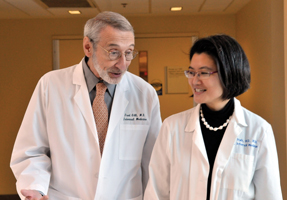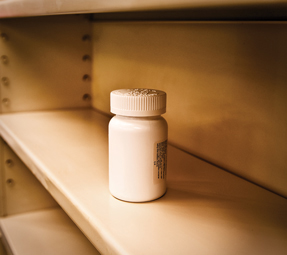Undiagnosed diseases program tries to crack the tough cases
When a condition stumps the experts, the experts turn to a center of last resort, the federal Undiagnosed Diseases Program at the National Institutes of Health. Medical teams take a “big picture” view and a fresh eye to pick up on what may have been missed.
Patients whose conditions stump their physicians may often feel isolated and doubted by family, friends and employers. Since 2008, however, they have had a place to go to make one more attempt to find an answer: the Undiagnosed Diseases Program (UDP) at the National Institutes of Health (NIH).
The program offers patients the opportunity to have their conditions thoroughly investigated by a diverse team of specialists in Bethesda, Md., at no charge. Visits are directed by a “chief investigator” of sorts, an internist who functions as patients' primary care physician while they are on site.

Fred Gill, MD, FACP, who is chief of the NIH's internal medicine consulting service, long ago developed a reputation for welcoming challenging cases that perplexed his colleagues. That reputation led him to become involved with the UDP, in addition to his other duties.
“I am always impressed by how many patients have significant medical problems that no one knows how to diagnose or treat,” said Dr. Gill. “Most patients are referred to this program by doctors who are quite committed to helping them, and they have already had significant workups, often at major medical centers such as Mayo, Johns Hopkins or Cleveland Clinic. But despite all that, everyone is still stumped.”
Program director William A. Gahl, MD, PhD, said that to be considered for entry, patients must be referred by a physician and submit their medical records for review. Only about a quarter of patients are accepted, typically 150 per year.
“We are especially looking for [cases that seem to have] a clue that we can follow, such as an abnormal radiological finding or a constellation of symptoms that we have not seen before, which gives us a marker for where to look,” he said.
The program is also always on the lookout for a possible genetic explanation, so having an affected sibling greatly improves a patient's chance of being accepted. Dr. Gahl brings a strong genetic perspective to his UDP work; his “real job” is as clinical director of the National Human Genome Research Institute.
“We would always like to find a unifying hypothesis for our patients, but we don't always get it, especially with genetic diseases because we don't always know how they will manifest themselves in the body,” he explained.
“Importantly, we need to maintain a high index of suspicion for all possibilities,” he added. “Our patients have previously seen many doctors and we need people with broad knowledge of disease to work with them. Also, we need people who can recognize that what they are seeing may be a new disease state entirely. We rely on internists who have knowledge of all possible manifestations of a disease and who are very experienced to work with these patients.”
A big-picture view
ACP Member Lisa Sanders, MD, who writes the “Diagnosis” column for the New York Times, as well as “Think Like a Doctor” for the newspaper's blog, said that internists are uniquely able to take a big-picture view of patients.
“They have their thumbs in all parts of the body,” said Dr. Sanders, who is also a technical consultant for television's medical mysteries drama “House M.D.” “They have a broader perspective, which is an important quality to have when sleuthing a tough diagnosis.”
Plus, she said, internists are often able to “backtrack” well, helping them spot the place on the diagnostic path where other physicians took a wrong turn, perhaps so long ago that they couldn't find the way back.
“There is a little detective story at the heart of every doctor-patient interaction,” she said.
In Bethesda, the story opens with a week of testing, imaging studies and specialist consultations planned by an internist such as Dr. Gill and a nurse practitioner.
“We really function as the primary care team,” Dr. Gill said. “Our job is to take in all the information and keep our eyes wide open because we have no idea what is wrong with the patient.”
First on the schedule is typically a two-and-a-half-hour history and physical, reviewing all the previous studies and the patient's current medical status, Dr. Gill said.
He then stays in close contact with the patients and the specialists they go on to see. Among the specialties available are rheumatology, immunology, oncology, mental health, nephrology, hematology, ophthalmology, neurology, endocrinology, dermatology, dentistry, pathology, pulmonology, cardiology and hepatology.
“After everyone has seen the patient, we all put our heads together and see if anyone has come up with an answer,” Dr. Gill said. “About 80% of the time, we don't. Then we know we have done everything we can to reach a diagnosis and this is truly an undiagnosed case. Even when we do make a diagnosis, there may be nothing we can do for the patient at this time.”
However, he added, teams do sometimes suggest treatment trials, in close communication with referring physicians, or bring a patient back for follow-up research.
When teams are able to make a new diagnosis, it is often for a rare disease or a rare manifestation of a disease. One such UDP discovery was published in the February 2011 New England Journal of Medicine: a degenerative disease causing arterial hardening from calcium deposits due to a rare protein deficiency in a group of nine siblings from three families.
Covering all bases
ACP Member Grace Park, MD, another UDP clinical attending internist, described her role as making sure all bases are covered, big and small.
“Specialists see what they are trained to see, and I try to get all of them to think together and make sure no avenue is left unexplored,” she said.
She compared the work to solving a huge puzzle.
“By the time they get here, patients have had all known conditions ruled out, and internists bring a lot to that situation by being good at thinking outside the box and seeing every patient as different,” Dr. Park said.
“Internists in general practice do this every day. The only difference here is that we have more resources available to us,” she added.
Value in coming
Even though most patients leave without firm answers, Dr. Gahl said they generally still are glad they came.
“They feel as if they have done all they can, that they have ‘been to Mecca,’” he said.
Only about 5% of the patients actually leave with a definitive new diagnosis. More commonly, they are able to shed some inaccurate diagnoses that have been attached to them along the way.
“Patients often come with 10 diagnoses, not one big mystery. Doctors want to put a label on conditions, and insurance encourages that,” said Dr. Gahl. “By ruling some of them out, we allow them to discontinue some medications that they are taking, and that alone can be liberating.
Patients also leave hopeful about the future, for themselves or for others, as the program continues to study genetic samples long after patients have left, opening the possibility that answers may come eventually, Dr. Gahl said.
Sometimes Dr. Gill calls referring physicians at the end of a visit, and even though he rarely has a firm answer for them, they are still quite appreciative of UDP's efforts.
“They are often just glad to know they have not missed something. Knowing that lets them go back to trying to treat the patient's problems to the best of their ability,” Dr. Gill said.
For more information about the Undiagnosed Diseases Program or to learn how to refer a patient, visit online.




